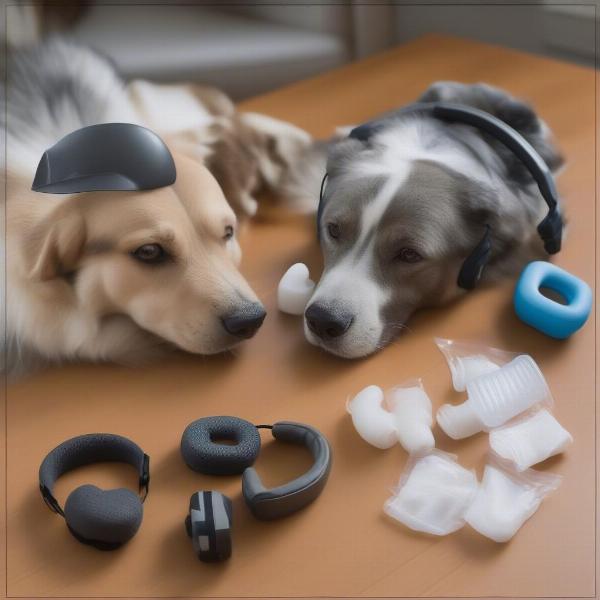Protecting your dog’s hearing during shooting activities is crucial for their long-term health and well-being. Loud noises from gunfire can cause significant and often irreversible damage to a dog’s sensitive ears. This guide covers everything you need to know about ear protection for dogs during shooting, from choosing the right gear to ensuring a comfortable and safe experience for your canine companion.
Understanding the Need for Ear Protection for Dogs
Dogs have a much wider hearing range than humans, making them more susceptible to noise-induced hearing loss. Exposure to loud noises like gunshots can cause pain, discomfort, and even permanent damage to the delicate structures of their inner ear. This can lead to hearing loss, tinnitus (ringing in the ears), and behavioral changes like anxiety or fear. Providing adequate ear protection not only prevents immediate discomfort but also safeguards your dog’s hearing for years to come.
 Choosing ear protection for hunting dogs
Choosing ear protection for hunting dogs
Types of Ear Protection for Dogs
There are two primary types of ear protection available for dogs: earmuffs and earplugs. Each has its pros and cons, and the best choice depends on your dog’s individual needs and preferences.
Earmuffs for Dogs
Earmuffs provide a physical barrier against loud noises, covering the entire ear canal. They are generally easier to fit and remove than earplugs and offer good protection against a wide range of frequencies. However, some dogs may find earmuffs bulky or uncomfortable, and they can interfere with the dog’s ability to detect subtle sounds in the environment.
Earplugs for Dogs
Earplugs are inserted into the dog’s ear canal, creating a seal that blocks out noise. They are generally smaller and less obtrusive than earmuffs, but they can be more challenging to insert correctly, especially for dogs with narrow or sensitive ear canals. Custom-molded earplugs offer the best fit and protection but can be more expensive.
Choosing the Right Ear Protection for Your Dog
When selecting ear protection for your dog, consider the following factors:
- Size and Breed: Ensure the ear protection fits snugly but comfortably. Measure your dog’s ear canal to ensure a proper fit for earplugs.
- Noise Reduction Rating (NRR): The NRR indicates the level of noise reduction provided by the ear protection. A higher NRR offers greater protection.
- Comfort and Fit: The ear protection should be comfortable for your dog to wear for extended periods. Look for lightweight and breathable materials.
- Ease of Use: Choose ear protection that is easy to put on and take off, especially if your dog is not accustomed to wearing it.
Acclimating Your Dog to Ear Protection
Introducing ear protection gradually is essential to ensure your dog accepts it without stress. Start by letting your dog sniff and investigate the ear protection. Reward them with treats and praise for positive interactions. Gradually increase the duration of wear, starting with short periods and gradually extending the time. Make positive associations with the ear protection by pairing it with enjoyable activities.
Tips for Using Ear Protection with Your Dog During Shooting
- Ensure the ear protection is properly fitted and secure before each shooting session.
- Inspect the ear protection regularly for signs of wear and tear.
- Monitor your dog for any signs of discomfort or distress.
- Remove the ear protection after the shooting activity is complete.
- Store the ear protection in a clean, dry place.
Conclusion
Protecting your dog’s hearing during shooting activities is a vital part of responsible dog ownership. By choosing appropriate ear protection and acclimating your dog to it gradually, you can ensure a safe and enjoyable experience for both of you. Remember, your dog’s hearing health is a long-term investment, and taking preventative measures now can save you from costly veterinary bills and potential behavioral issues down the road. Don’t hesitate to consult with your veterinarian if you have any concerns about your dog’s hearing or choosing the right ear protection.
FAQ
- Is ear protection necessary for all dogs during shooting? Yes, it’s highly recommended to protect all dogs from the loud noises of gunfire.
- Can I use human earplugs for my dog? It’s best to use earplugs specifically designed for dogs to ensure a proper and safe fit.
- How do I know if my dog’s ear protection is working? Observe your dog’s behavior. If they seem calmer and less reactive to the noise, the ear protection is likely effective.
- What should I do if my dog refuses to wear ear protection? Try different types or sizes. Consult with a professional dog trainer for assistance with acclimation.
- How often should I replace my dog’s ear protection? Replace them as soon as they show signs of wear and tear, or as recommended by the manufacturer.
- Can ear infections be caused by ear protection? If the ear protection isn’t kept clean or if it traps moisture, it could contribute to ear infections.
- What are some signs of noise-induced hearing loss in dogs? Signs can include tilting their head, not responding to commands, whining or whimpering in response to loud noises, and changes in behavior.
Related Articles on ILM Dog
About ILM Dog
ILM Dog is your trusted global resource for expert dog care advice and guidance. We offer comprehensive information on dog breeds, health, training, nutrition, grooming, and much more, catering to both new and experienced dog owners. From choosing the right breed to understanding complex health issues, ILM Dog provides practical advice and resources to help you provide the best possible care for your canine companion. For any inquiries or to learn more about our services, contact us via email at [email protected] or phone at +44 20-3965-8624.